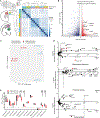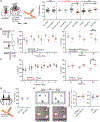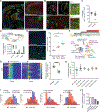A Thalamic Orphan Receptor Drives Variability in Short-Term Memory
- PMID: 32997977
- PMCID: PMC7572771
- DOI: 10.1016/j.cell.2020.09.011
A Thalamic Orphan Receptor Drives Variability in Short-Term Memory
Abstract
Working memory is a form of short-term memory that involves maintaining and updating task-relevant information toward goal-directed pursuits. Classical models posit persistent activity in prefrontal cortex (PFC) as a primary neural correlate, but emerging views suggest additional mechanisms may exist. We screened ∼200 genetically diverse mice on a working memory task and identified a genetic locus on chromosome 5 that contributes to a substantial proportion (17%) of the phenotypic variance. Within the locus, we identified a gene encoding an orphan G-protein-coupled receptor, Gpr12, which is sufficient to drive substantial and bidirectional changes in working memory. Molecular, cellular, and imaging studies revealed that Gpr12 enables high thalamus-PFC synchrony to support memory maintenance and choice accuracy. These findings identify an orphan receptor as a potent modifier of short-term memory and supplement classical PFC-based models with an emerging thalamus-centric framework for the mechanistic understanding of working memory.
Keywords: GPCR; RNA; genetic Variation/genetics; genome/genetics; memory/physiology; messenger/analysis; mice; neural pathways/physiology; outbred; prefrontal cortex/physiology; quantitative trait loci/genetics; thalamus/cytology; thalamus/physiology; transcriptome/genetics.
Published by Elsevier Inc.
Conflict of interest statement
Declaration of Interests The authors declare no competing interests.
Figures






Comment in
-
Genetic variability of memory performance is explained by differences in the brain's thalamus.Nature. 2020 Nov;587(7835):549-550. doi: 10.1038/d41586-020-03195-3. Nature. 2020. PMID: 33199900 No abstract available.
References
-
- Akrami A, Kopec CD, Diamond ME, and Brody CD (2018). Posterior parietal cortex represents sensory history and mediates its effects on behaviour. Nature 554, 368–372. - PubMed
-
- Arnsten AF, and Jin LE (2014). Molecular influences on working memory circuits in dorsolateral prefrontal cortex. Prog. Mol. Biol. Transl. Sci 122, 211–231. - PubMed
-
- Baddeley A (2003). Working memory: looking back and looking forward. Nat. Rev. Neurosci 4, 829–839. - PubMed
-
- Baddeley A (2012). Working memory: theories, models, and controversies. Annu. Rev. Psychol 63, 1–29. - PubMed
-
- Baddeley AD, and Hitch G (1974). Working Memory. Psychology of Learning & Motivation 8, 47–89.
Publication types
MeSH terms
Substances
Grants and funding
LinkOut - more resources
Full Text Sources
Molecular Biology Databases
Research Materials
Miscellaneous

